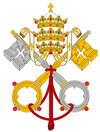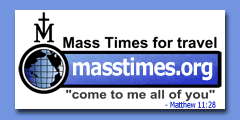
The Vatican

Catholic Parents
Online

Good Counsel Homes


Faithful Citizenship
Current News from:

American Life League
pro-life Americans


Catholic Pro-Life
Committee
|
Cardinal DiNardo lectures on Vatican II liturgy document
Renee Webb -- Catholic Globe -- Oct 18, 2013
The chatter and excitement continued to build in the St. Francis Center on the Briar Cliff University campus in Sioux City on Oct. 9 as hundreds awaited the arrival of Cardinal Daniel N. DiNardo.
Applause echoed through the room as Cardinal DiNardo, former bishop of Sioux City who now heads the Archdiocese of Galveston-Houston, entered the room to present his lecture for the Sister Ruth Agnes Ahlers Lecture Series.
Bev Wharton, president of Briar Cliff University, said this time of year is always a time of joy and celebration at the university as they just, days earlier, celebrated the Feast of St. Francis of Assisi.
"Your presence, Cardinal DiNardo, has magnified the level of excitement. We are so grateful you will share your gifts once again with us," Wharton said. "Cardinal DiNardo, one of the key principles of Briar Cliff University is our openness to all. Tonight, people of all faiths have come to hear your words of grace and we are blessed to have you with us."
Prior to the lecture, Bishop Walker Nickless offered the opening prayer and theology professor Linda Harrington introduced Cardinal DiNardo.
Before delving into his theological talk centered on the Second Vatican Council's document on the liturgy, the cardinal opened on a light note. He said the Friday before coming to Sioux City, he was checking the weather station because he is very worried about hurricanes and something felt as if it was brewing.
"And what's on? Nothing about hurricanes. 'There's a great problem going on in northeast Nebraska and northwest Iowa.' I said, boy do I feel at home, I remember those things," Cardinal DiNardo said.
The lecture
Cardinal DiNardo described the opening of the Second Vatican Council in October of 1962 as possibly the major event of the Catholic Church in the 20th Century.
"The progress of that council - its meanings, its commissions, its documents and yes, even its intrigues - constitute a remarkable richness for the renewal of the church throughout the world," he said.
That renewal, he added, was picked up intensely by the church in the United States.
Cardinal DiNardo explained the first major constitution to be voted on and approved by the (Vatican II) council fathers in 1963 was the constitution on the sacred liturgy.
"It was to set the tone for much else that was to follow in the documents of Vatican II," he said. "We cannot underestimate the importance of this document, not just for what it says but also for the way it spoke about renewal and reform."
The documentary on the liturgy, the cardinal noted, set a course that guided all future documents of the council - 16 in all.
During this Year of Faith, Cardinal DiNardo said it provides an interesting position, 50 years after Second Vatican Council, to look at what was happening then, what has happened in subsequent years as well as current conversations and debates.
One of the greatest debates, he said, centers on the continuity/discontinuity interval.
"Most everyone agrees that the church was in need of reform and that the council fathers wanted renewal and reform," said the cardinal, but added there are questions if the sense of renewal was something the church was already living - a renewal within continuity - or was it more of a rupture?
Cardinal DiNardo said it is clear to him that this Vatican II document had the most direct effect and change on the life of the faithful - especially in the United States. It was also the one area where there had already been much preparation and thinking.
Major points
During his lecture, the cardinal did three things: 1) Present a backdrop of the movement that existed prior to Vatican II. 2) Analyze a few significant global concepts of the liturgy constitution and the direct reform items the council fathers mandated. 3) Identify three particular aspects of the liturgical reform which he considered to be crucial in the last three years - the vernacular (language of the people) in the liturgy, the expanded use of
Scripture by the use of the Lectionary and the introduction of multiple Eucharistic prayers into the rites of the Mass.
Cardinal DiNardo explained in the late medieval period during the time of the Council of Trent, there was so much variety in liturgy that the council introduced a liturgical commission. Unfortunately, though, that commission was not able to meet often so the pope moved forward and promulgated the missal of 1570.
"Pope Pius V did a very important thing - he stabilized the situation. He brought sanity to the liturgy," said the cardinal, who added the pope began to standardize text and rubrics.
The speaker also noted even at the Council of Trent, St. Charles Borromeo asked for the vernacular for the first part of the Mass. The response through the Holy See was that while it could be done, the timing wasn't right.
That saint also asked that Communion from the chalice be delivered to the people, but again it was an inopportune time.
"My point is that some of the issues we have spoken about were already being spoken about in the 1570s and '80s," Caridnal DiNardo said.
He cited other noteworthy movements and individuals through the years. For instance, the 19th Century was known for revival of the biblical movement and interest in chant. Experiences with immigrants here in the U.S. even had impact. The cardinal said in this country, social justice played a large part in liturgical reform.
Significant changes
The speaker went on to say the Second Vatican Council did something significant by theologically identifying the liturgy as the work of both the head and members.
"It then goes on to state the Holy Mother Church earnestly desires that all the faithful should be led to full, conscious and active participation in liturgical celebrations demanded by the very nature of the liturgy," Cardinal DiNardo said.
He acknowledged that for some, this was earth-shattering - a big change.
The fathers of the council only made general statements about what they wanted to see done and the speaker highlighted a few of them.
"The council stated that Latin was to be kept in the Latin liturgy and is to be upheld in honor," Cardinal DiNardo said. "Then it goes on to say that because of pastoral concerns, the vernacular should be utilized in the liturgy and should be asked for by conferences of bishops. This was in 1963. The bishops of the United States immediately asked for the vernacular for the first part of Mass."
By 1965, the first part of the Mass was in English and the second part was in Latin. Then, by the time a new missal was published in 1970, it was published as a complete English translation.
The cardinal said he thinks the use of the vernacular in liturgy is very good and important. However, he does not believe that the council's first statement about not losing Latin in the Mass has not been upheld. The way he believes this can be done is through Latin songs.
Lectionary examined
His address then moved into discussion about the expanded Lectionary and the move to a three-year cycle to open up the richness of Scripture.
"What they tried to do in the new Lectionary was give us more Scripture, to give us a richness of Scripture so that the Liturgy of the Word would indeed be a way of instruction God's people," said the cardinal, who mentioned most Christian, non-Catholic western churches adopted a similar Lectionary.
Cardinal DiNardo said this change revealed a weakness in preaching because priests were not prepared to unpack the readings.
"If you ask me what I consider to be one of the greatest results of Vatican II, it is both faithfulness and innovation in making sure God's word gets heard by God's people," he said.
The lecture then turned to his final point about the addition of Eucharistic prayers. The cardinal noted that for 1,500 years there was only one prayer. Rather than changing that prayer, they opted to keep the original
Roman Canon as is and add three more versions.
Given that there were already 100-plus renegade Eucharistic prayers circulating, the cardinal noted the pope didn't object. Since that time, a few more additions have been made.
While some still think there should only be one Eucharistic prayer, the cardinal said, "I disagree with that. I think there is beauty in the richness that has been added to our Eucharistic praying."
Cardinal DiNardo said the vernacular, expanded Lectionary and use of multiple Eucharistic prayers in the long run have been a great reward for the church. He said, "The council set in motion a renewal of the church, not just a reform."
The cardinal said while there were ups and downs with the vast and fast pace of the changes that took place during the 1960s, he added, "From the point of view of 50 years, I think the gains outweigh the losses and the church is more enriched and better for the kind of liturgical renewal that we have had."
http://www.catholicglobe.org/Renee10.17.13b.html
Please visit Courageous Priest for more: www.courageouspriest.com
|
Catholic Places
Shrines, Basilicas, Cathedrals
Beautiful Holy Places
Catholic Gifts
Scapulars. Jewelry. Crucifixes
Stylish & Modest Fashion
|